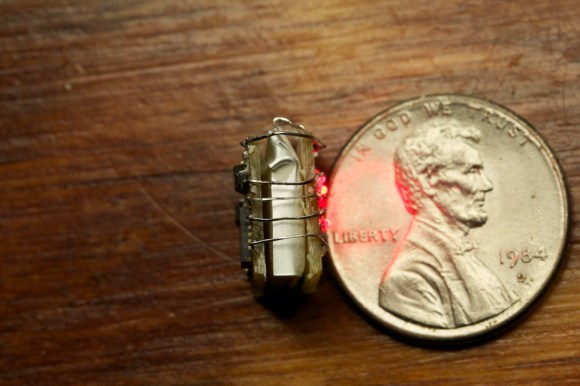
Unfortunately [ch00f’s] been too busy to write for Hack a Day lately, but he has finished off an awesome little project — Christmas LED earrings!
As with all his projects, there is a brilliant write up that covers everything — even for the stuff that didn’t work. But what we really have to admire about this project in particular is the scale at which he was working. The tiny battery squished in between the two boards? A mere 19mAh. Which is actually enough to power the earrings for a few hours, but is only the size and thickness of a few microSD cards!
The second thing that really popped out at us was the boards themselves, there’s just no room for a programming header! To work around this [ch00f] actually made the PCBs in 3 segments, programmed it, and then cut off the programming header section! If that’s not enough ingenuity, how about this – He also included hall effect sensors on-board to turn them off while charging! Not to mention an intricate wood box to charge them in…
Stick around after the break to see the great demo video, it even has some classy music from the 1930’s which really sets the mood.















Määh,
Youtube content not available in germany due to the 1930s music…
Move to Poland then, our internets are not bothered by copyright laws.
Hope you’re just being sarcastic.
BTW it’s not a good idea to invite Germans to Poland, as history proved -.-‘
//Sarcastic refers to the copyright laws obviously//
He’s pretty much correct, our laws let us download any (released) music and movies from the Internet on the same basis like you can record a song from a radio or record a tv show on PVR and not worry if radio/tv station has a licence to broadcast it. And our RIAA equivalent isn’t as “active” as German one
>For a while, I was cranking my hot air rework gun up to 360-400C
figuring that it should be around the same temperature as my soldering
iron.
It is not a good idea to crank up the soldering iron that hot either. It
is bad for your tips and parts. I set my soldering iron to 260C (500F)
and it is sufficient for most of my soldering work. I would only use the
higher settings for heavy gauge wires, solder tabs etc.
Some parts such as SMT LED or chips explicitly tells you the maximum
temperature and maximum time (reflow profile). SMT LED packages can melt.
I guess i should do a project page about my blinky badges and earrings at some point…
Just like I made some a few months ago: http://www.vagrearg.org/content/blinkring
Nerdy jewelry :-)
ok then buy 30000 cells and take the ones you need and sell the rest on ebay.
or go overseas and bring one home carryon.
or buy one
http://www.hobbyking.com/hobbyking/store/__472__172__FPV_Telemetry-Video_Recorders.html
and tear it down for the battery.
also you can get a hand crank flashlight
http://www.conciergematch.com/wp-content/uploads/2010/10/Hand-Crank-Flashlight.jpg
it uses a quarter sized lithium cell (i know because i used to have one of those flashlights and the gears for the generator stripped out so it no longer cranked).
Back in the day, (1980’s) I used to make earnings with a really cool little chip. An LM3815 was brilliant as an LE flasher, one capacitor, a button cell pressed between the lower legs and an LED. things would last for ages.
oops, it was a LM 3090 hell its been a long time. I just found one sitting in a box :)
I’m just guessing, but the LM3815 you are referencing is probably a mis-memory of the part number for the VU series of chips that would display voltage or current levels amongst ten LEDs. The flasher chip you are referring to would be the LM3909. Great solution in it’s time(and available at Radio Shack), but now you can get LEDs with various flashers/sequencers built in that require less current.
Woooow. The project is cool, but what really hit me is the ch00f’s style of explaining things, solutions, showing the troubleshooting he went through etc. Man, that was a hell of a great lecture and great inspiration! Even though I didn’t understand half of the stuff I found myself eager to read on. I wish I could do something like that. Really, that was great super cool
“I think LEDs are rapidly becoming the “put a bird on it” of my blog…”
Winning.